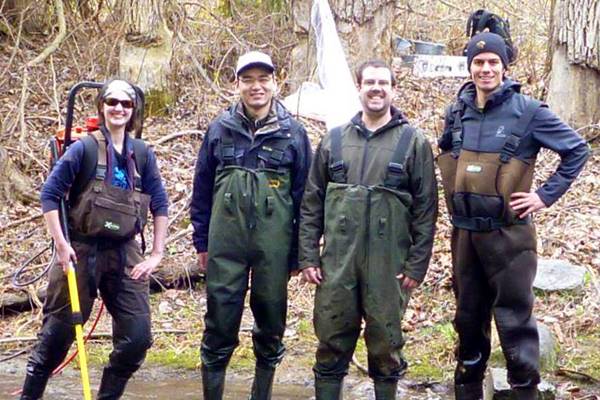Rainbow trout may stymie Atlantic salmon restoration in Lake Ontario
Rehabilitating a particular fish population isn’t as simple as dropping a bunch of the same species into the deficient pond or stream. A number of factors come into play, including cost, the habitat’s carrying capacity and potential competition from other species. A team of Canadian researchers studied the latter in a project to reintroduce Atlantic salmon to Lake Ontario.
“On the Ontario side, there’s been efforts to try to restore Atlantic salmon in Lake Ontario,” said Aimee Houde, a doctoral candidate at the University of Western Ontario. “There used to be a population there in the 1900s, but habitat degradation wiped it out.”
Following the loss of Atlantic salmon in Lake Ontario, wildlife managers introduced rainbow trout to the area to create a sustainable fishery and deal with the growing crayfish population. The trout drew little attention until the 1990s, when salmon restoration efforts started — and repeatedly failed to take hold.
The study, conducted by Houde and researchers from Université du Québec à Montréal and the Ontario Ministry of Natural Resources and Forestry, explores the possibility that rainbow trout are stifling Atlantic salmon recovery in Lake Ontario. The researchers conducted experiments in two natural streams to see how LaHave and Sebago Atlantic salmon populations fared in the presence of rainbow trout. Their findings were published in the scientific journal Ecology of Freshwater Fish.
An earlier study from the researchers had looked at trout and salmon competition in artificial streams. This time around, the researchers sought out natural waterways with which they could compare their previous results. Water flow and accessibility were the two biggest deciding factors in the search, which became somewhat of an obstacle to the researchers.
“It was challenging just to find those two sites to begin with,” Houde said. “Particularly in Ontario, we’re kind of restricted to areas that are property of the conservation authority or Crown land.”
The researchers settled on two sites on Duffins Creek. A dam prevented the upstream movement of rainbow trout past a certain point, effectively creating one site with, and another site without the salmon competitors.
To obtain an ample stock of Atlantic salmon, the researchers bred five females with five males “in all possible combinations,” Houde said. The pairings produced enough fry to release just under 2,000 at each site in May. Between October and November, the researchers went back to the sites and performed electrofishing to determine recapture rate and specimen size. With those statistics tallied, the researchers surveyed microhabitat usage among salmon in each stream.

From left to right, the PhD students and electrofishing crew: Aimee Lee Houde, Xiaoping He, Craig Black, and Andrew Smith. (Credit: Aimee Lee Houde)
“We found that out of the available habitat, in the presence of rainbow trout, [salmon] tended to occupy areas that were less profitable for them,” Houde said.
In this case, “less profitable” means less productive, a disadvantage that manifested itself in the form of smaller salmon. The rainbow trout had overtaken the parts of the stream with optimal temperatures and better access to food. Houde noted that the Sebago population did better than the LaHave population in the rainbow trout’s presence. Though she said the researchers can only speculate based on previous studies, it seems that the Sebago salmon avoided interaction with trout and other species, therefore conserving energy and necessitating less food for growth.
The researchers have submitted grant proposals to conduct a more in-depth study on the issues plaguing Atlantic salmon restoration efforts. While the inefficient habitat use they observed is an important piece of that puzzle, they’re particularly interested in studying obstacles to the fish’s survival at earlier stages.
“The big question is what are the sources of mortality for the juveniles,” Houde said.



0 comments